高考英语二轮复习课件:特殊句式(共41张PPT)
文档属性
| 名称 | 高考英语二轮复习课件:特殊句式(共41张PPT) | 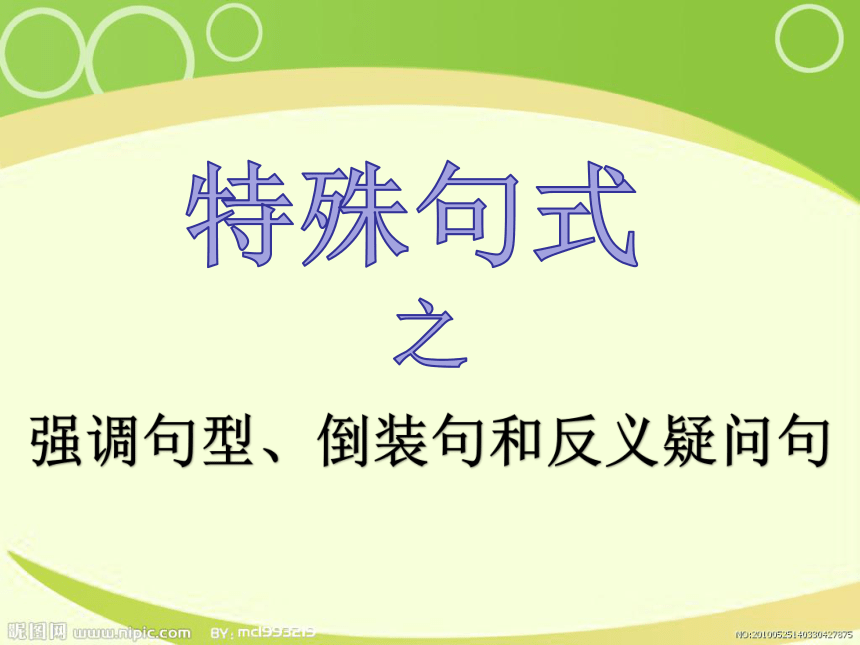 | |
| 格式 | zip | ||
| 文件大小 | 283.5KB | ||
| 资源类型 | 教案 | ||
| 版本资源 | 通用版 | ||
| 科目 | 英语 | ||
| 更新时间 | 2019-08-06 21:10:05 | ||
图片预览

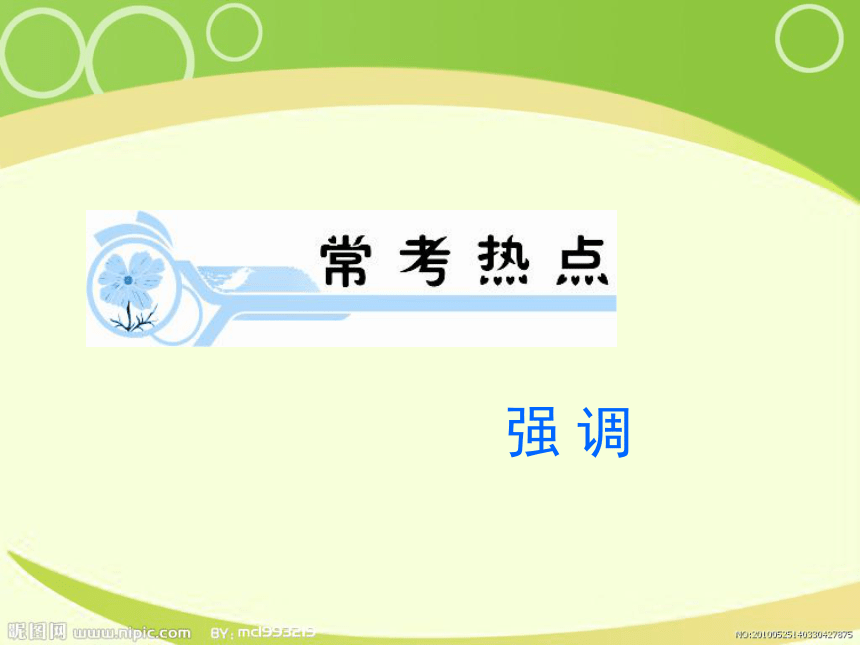
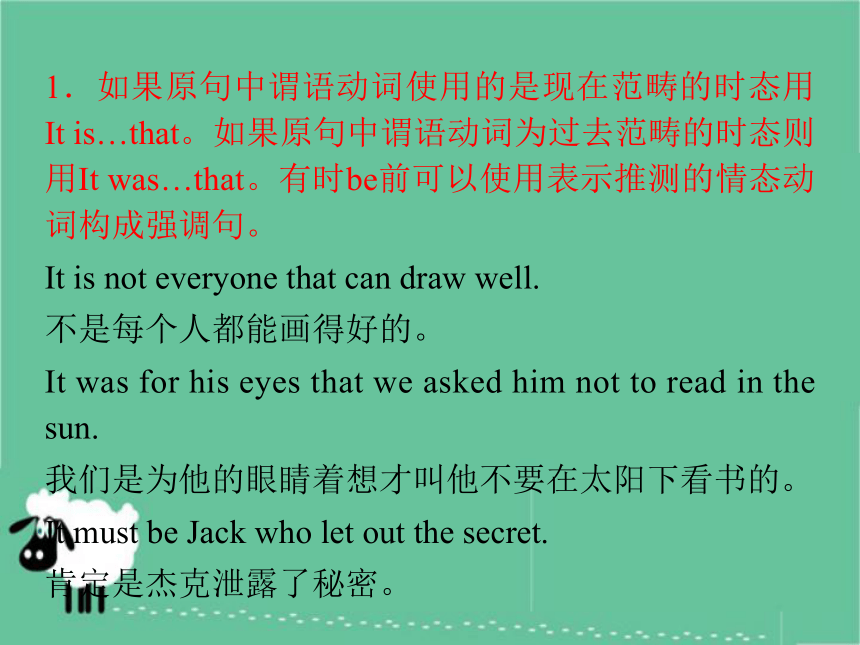
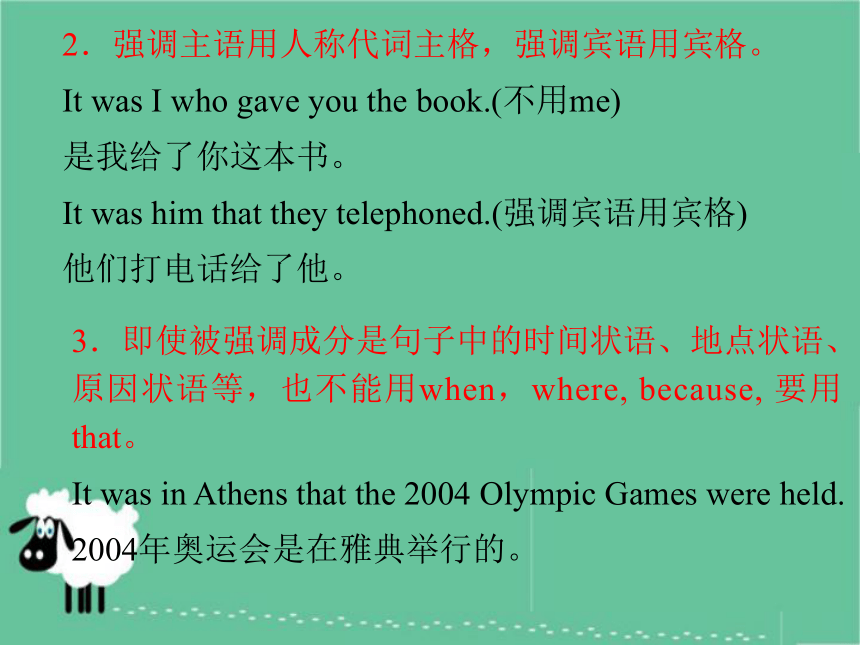
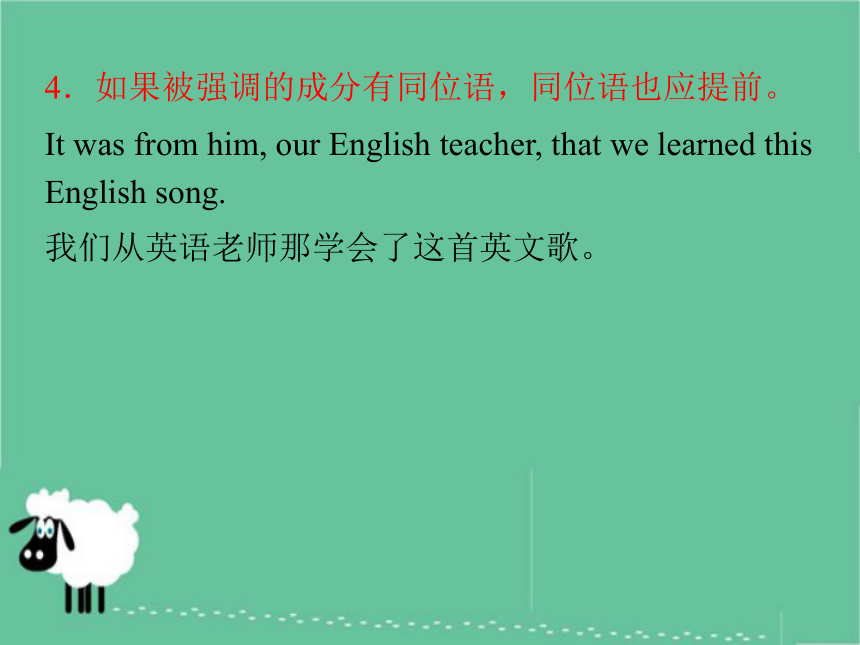
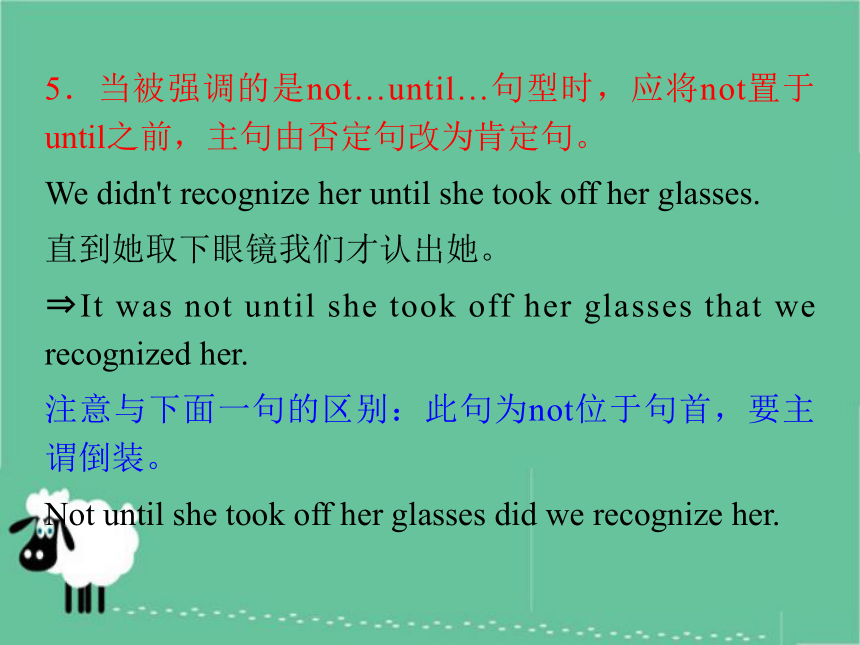
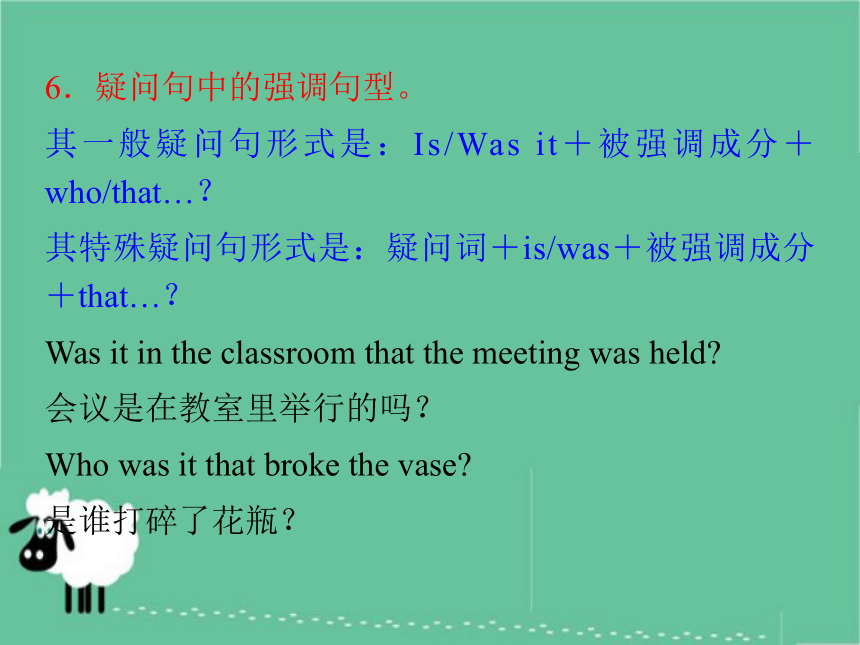
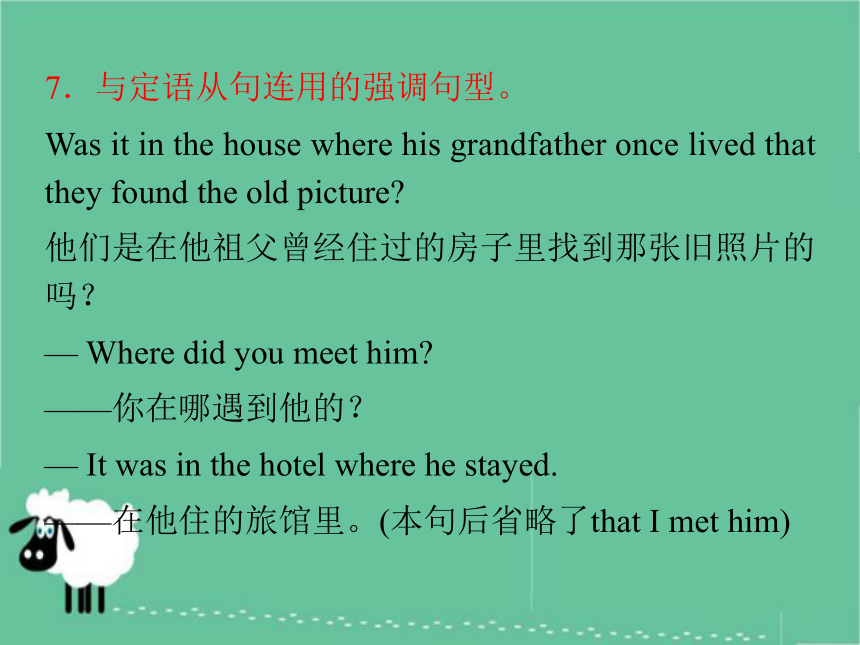

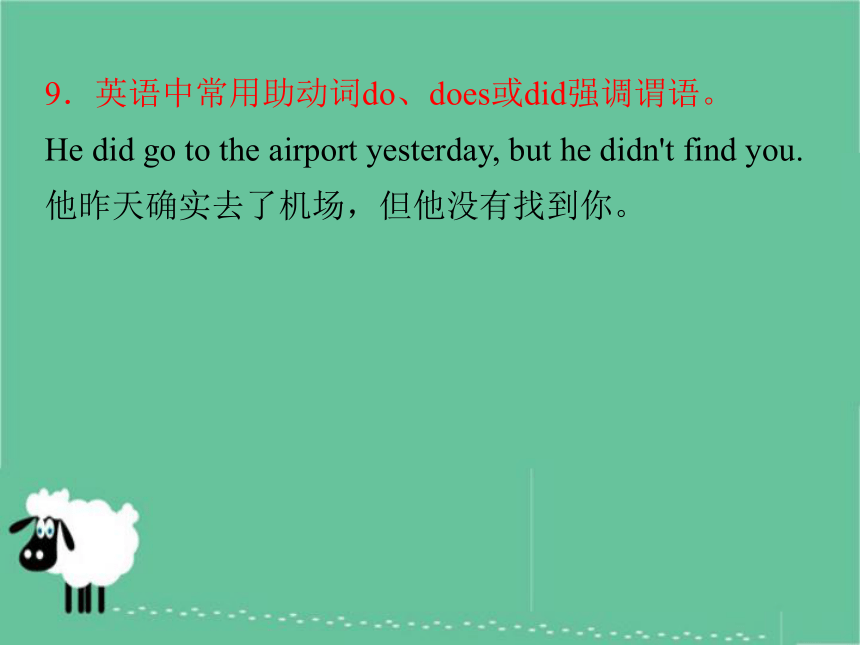
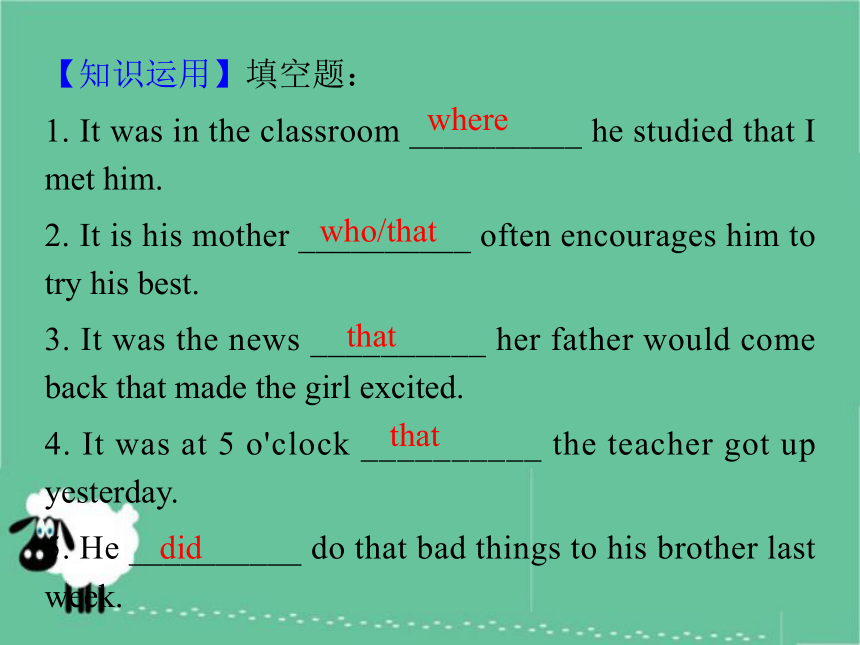
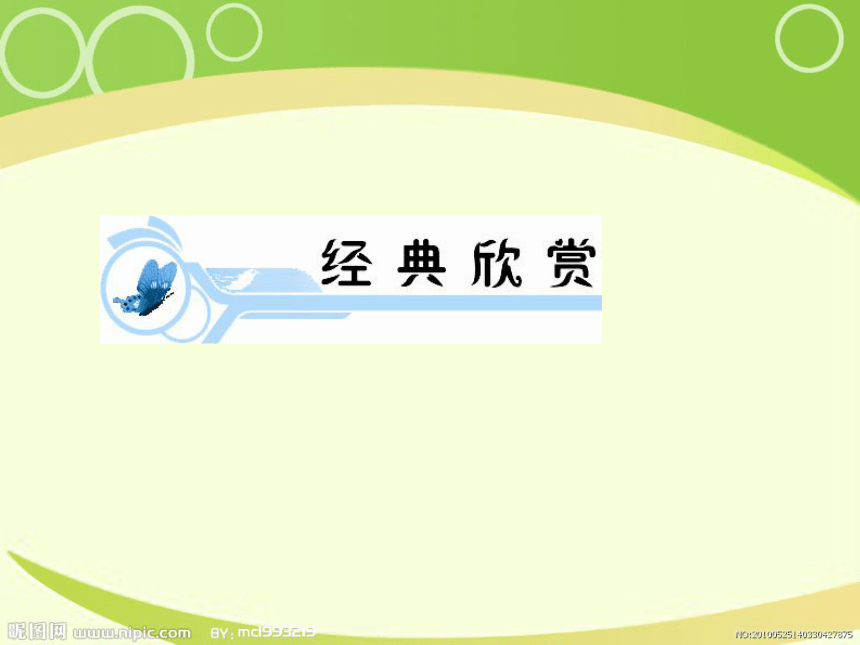
文档简介
课件41张PPT。特殊句式之强调句型、倒装句和反义疑问句强 调 1.如果原句中谓语动词使用的是现在范畴的时态用It is…that。如果原句中谓语动词为过去范畴的时态则用It was…that。有时be前可以使用表示推测的情态动词构成强调句。
It is not everyone that can draw well.
不是每个人都能画得好的。
It was for his eyes that we asked him not to read in the sun.
我们是为他的眼睛着想才叫他不要在太阳下看书的。
It must be Jack who let out the secret.
肯定是杰克泄露了秘密。2.强调主语用人称代词主格,强调宾语用宾格。
It was I who gave you the book.(不用me)
是我给了你这本书。
It was him that they telephoned.(强调宾语用宾格)
他们打电话给了他。3.即使被强调成分是句子中的时间状语、地点状语、原因状语等,也不能用when,where, because, 要用that。
It was in Athens that the 2004 Olympic Games were held.
2004年奥运会是在雅典举行的。4.如果被强调的成分有同位语,同位语也应提前。
It was from him, our English teacher, that we learned this English song.
我们从英语老师那学会了这首英文歌。5.当被强调的是not…until…句型时,应将not置于until之前,主句由否定句改为肯定句。
We didn't recognize her until she took off her glasses.
直到她取下眼镜我们才认出她。
?It was not until she took off her glasses that we recognized her.
注意与下面一句的区别:此句为not位于句首,要主谓倒装。
Not until she took off her glasses did we recognize her.6.疑问句中的强调句型。
其一般疑问句形式是:Is/Was it+被强调成分+who/that…?
其特殊疑问句形式是:疑问词+is/was+被强调成分+that…?
Was it in the classroom that the meeting was held?
会议是在教室里举行的吗?
Who was it that broke the vase?
是谁打碎了花瓶?7.与定语从句连用的强调句型。
Was it in the house where his grandfather once lived that they found the old picture?
他们是在他祖父曾经住过的房子里找到那张旧照片的吗?
— Where did you meet him?
——你在哪遇到他的?
— It was in the hotel where he stayed.
——在他住的旅馆里。(本句后省略了that I met him)8.与其他状语从句的区别
It was at 7 o'clock that I arrived. (强调句型,强调时间状语at 7 o'clock )
It was 7 o'clock when I arrived.(when时间状语从句。在7 o'clock前无介词at)
主要搞清楚的一点是:强调句型中去掉It is/was…that后仍然是一个完整的句子。而其他句型则不行。9.英语中常用助动词do、does或did强调谓语。
He did go to the airport yesterday, but he didn't find you.
他昨天确实去了机场,但他没有找到你。【知识运用】填空题:
1. It was in the classroom __________ he studied that I met him.
2. It is his mother __________ often encourages him to try his best.
3. It was the news __________ her father would come back that made the girl excited.
4. It was at 5 o'clock __________ the teacher got up yesterday.
5. He __________ do that bad things to his brother last week.wherewho/thatthatthatdid1. — Was it under the tree ________ you were away talking to a friend?
— Sure. But when I got back there, the bike was gone.
A. that B. where
C. which D. while2. It was lack of money, not of effort, ________ defeated their plan.
A. which B. as
C. that D. what3. An awful accident ________, however, occur the other day.
A. does B. did
C. has to D. had to倒 装 1.here, there, away, in, out, down, up, off, back, now, then等在句首时是全部倒装。Here is coming the bus.2.介词短语或方位名词词组作地点状语位于句首,是全部倒装。
注意:以上两种完全倒装结构中,主语必须是名词,谓语常是表示方位或转移的不及物动词,如lie, live, sit, stand, be, come, go, rise, walk, run等,主语若是人称代词或谓语不属上述动词之列,则不用完全倒装。
Here it rains a lot every month of the year.
今年本地区每月雨量充裕。 3.代词such作表语,意为“这样的人”、“这样的物”,应置于句首,其后全部倒装。
Such were the facts.
事实就是这样。4.only修饰动词、介词短语、状语从句,并置于句首时,主句中是部分倒装。
Only when the rain stopped did the match start again.
雨停后比赛才能开始。
注意:“only+名词/代词”置于句首不要倒装。
Only he can do it.只有他才会这么干。5.否定意义的副词,如:not, never, neither, nor, seldom, hardly, little等置于句首时,是部分倒装。
Hardly can I believe that.
我绝不相信。6.not only…but (also)…连接两个分句,not only置于句首,它所引导的这部分要部分倒装,但but(also)部分不要倒装。
Not only should we study science, but also we should pay attention to politics.
我们不仅要学习科学知识,也要关注政治。
注意:若not only…but (also)…连接两个主语时,句子不要倒装。7.not until引起一个短语或引导一个从句置于句首时,主句中要求部分倒装。
Not until he was ten did he go to school.
直至10岁他才上学。
8.so表示“也”、“同样”,位于句首时,其后要部分倒装。
You can swim, so can I.
你会游泳,我也会。【知识运用】填空题:
1. Not only __________ he __________ (like) swimming but also he likes football.
2. No sooner had he __________ (see) the stranger than he shouted at him.
3. My mother has read the book, and so __________ I.
4. Only by working hard __________ we __________ (achieve) high grades. doeslikeseenhavecan/willachieve1. Then ________ a new development that had far-reaching effects.
A. come B. coming
C. came D. had come2. Hard ________ he studies, he cannot pass the examination.
A. when B. how
C. as D. while3. ________ loudly did he speak that even the people in the next room could hear him.
A. So B. Very
C. Too D. Much反意疑问句 除了“基本用法”中涉及的,下面总结11种特殊的反意疑问句用法:
1.祈使句:祈使句后一般加上will you 或won't you 构成反意疑问句,用will you 多表示“请求”,用won't you多表示提醒对方注意。
Mail the letter today, will you?
今天就把信发掉,好吗?
Try to be back by two, won't you?
尽量两点之前回来,好吗?若陈述部分为否定式,则反意疑问句部分只用will you。
Don't forget to post the letter, will you?
请别忘了寄信。
当祈使句为Let's…时,反意疑问句总是用 shall we。
Let's phone her now, shall we?
我们现在就给她打电话,好吗?2.感叹句:感叹句后加反意疑问句时,其反意疑问句需用be 的一般现在时态的否定形式。
What a moving film (it is), is it?
多感人的电影啊,是吗?
3.当陈述部分谓语动词是need, dare, used to 且这些词被用作实义动词时,其反意疑问句须用do 的适当形式。
They need to move to the east, don't they?
他们需要搬到东方去,是吗?4.当陈述部分主、谓语是I am…时,反意疑问句用aren't I 或ain't I, 而不是am not I (可用am I not)。
I'm a student, aren't I /ain't I?
我是学生,对吗?
5.当陈述部分主语是从句、不定式(短语)、动词-ing 形式时,反意疑问句的主语应该用it。
Doing sports is very important, isn't it?
做运动很重要,是吗?
That he came late was impossible, wasn't it?
他迟到是不能的,是吗?7.当陈述部分含I think (believe,suppose…)that…结构时,其反意疑问句须与从句的主、谓语保持一致,注意主句的主语必须是第一人称。
I don't think he will go there, will he?
我认为他不会去那里,是吗?(注意否定前移)
He believed that he had lost his keys, didn't he?
他认为他已经丢了钥匙,是吗?(主句主语不是第一人称)8.当have (has) 是表示“有”的意思,并在句中作谓语时,其反意疑问句的助动词要用do, does, did。
He has three books, hasn't he/doesn't he?
他有3本书,是吗?(have意思是“有”)
He had his hair cut yesterday, didn't he?
他昨天理发了,是吗?(have 意思不是“有”)
9.当陈述部分有have to 时,其反意疑问句要用助动词的否定形式。
They have to leave at last, don't they?
他们最后不得不离开,是吗?10.当陈述部分有had better 时,其反意疑问句要用hadn't。
We had better go there by bus, hadn't we?
我们最好坐汽车去那里,是吗?
11.当陈述部分含有情态动词must时,我们最好分析一下must的含义。如果must作“一定;要;必须”讲,反意疑问句须用mustn't或needn't;而当must作推测意义“一定是;必定”讲时,反意疑问句则需根据must后的动词原形选相应的形式。 You must do it, needn't you?/mustn't you?
你必须做这件事,是吗?
You must be hungry, aren't you?
你一定饿了,是吗?
You must know how to answer the question, don't you?
你一定知道如何回答这个问题,是吗?1. — Alice, you feed the bird today, ________?
— But I fed it yesterday.
A. do you B. will you
C. didn't you D. don't you 2. — I don't like him, ________?
— No, I don't at all.
A. do I B. do you
C. don't I D. does sheTHANK YOU
It is not everyone that can draw well.
不是每个人都能画得好的。
It was for his eyes that we asked him not to read in the sun.
我们是为他的眼睛着想才叫他不要在太阳下看书的。
It must be Jack who let out the secret.
肯定是杰克泄露了秘密。2.强调主语用人称代词主格,强调宾语用宾格。
It was I who gave you the book.(不用me)
是我给了你这本书。
It was him that they telephoned.(强调宾语用宾格)
他们打电话给了他。3.即使被强调成分是句子中的时间状语、地点状语、原因状语等,也不能用when,where, because, 要用that。
It was in Athens that the 2004 Olympic Games were held.
2004年奥运会是在雅典举行的。4.如果被强调的成分有同位语,同位语也应提前。
It was from him, our English teacher, that we learned this English song.
我们从英语老师那学会了这首英文歌。5.当被强调的是not…until…句型时,应将not置于until之前,主句由否定句改为肯定句。
We didn't recognize her until she took off her glasses.
直到她取下眼镜我们才认出她。
?It was not until she took off her glasses that we recognized her.
注意与下面一句的区别:此句为not位于句首,要主谓倒装。
Not until she took off her glasses did we recognize her.6.疑问句中的强调句型。
其一般疑问句形式是:Is/Was it+被强调成分+who/that…?
其特殊疑问句形式是:疑问词+is/was+被强调成分+that…?
Was it in the classroom that the meeting was held?
会议是在教室里举行的吗?
Who was it that broke the vase?
是谁打碎了花瓶?7.与定语从句连用的强调句型。
Was it in the house where his grandfather once lived that they found the old picture?
他们是在他祖父曾经住过的房子里找到那张旧照片的吗?
— Where did you meet him?
——你在哪遇到他的?
— It was in the hotel where he stayed.
——在他住的旅馆里。(本句后省略了that I met him)8.与其他状语从句的区别
It was at 7 o'clock that I arrived. (强调句型,强调时间状语at 7 o'clock )
It was 7 o'clock when I arrived.(when时间状语从句。在7 o'clock前无介词at)
主要搞清楚的一点是:强调句型中去掉It is/was…that后仍然是一个完整的句子。而其他句型则不行。9.英语中常用助动词do、does或did强调谓语。
He did go to the airport yesterday, but he didn't find you.
他昨天确实去了机场,但他没有找到你。【知识运用】填空题:
1. It was in the classroom __________ he studied that I met him.
2. It is his mother __________ often encourages him to try his best.
3. It was the news __________ her father would come back that made the girl excited.
4. It was at 5 o'clock __________ the teacher got up yesterday.
5. He __________ do that bad things to his brother last week.wherewho/thatthatthatdid1. — Was it under the tree ________ you were away talking to a friend?
— Sure. But when I got back there, the bike was gone.
A. that B. where
C. which D. while2. It was lack of money, not of effort, ________ defeated their plan.
A. which B. as
C. that D. what3. An awful accident ________, however, occur the other day.
A. does B. did
C. has to D. had to倒 装 1.here, there, away, in, out, down, up, off, back, now, then等在句首时是全部倒装。Here is coming the bus.2.介词短语或方位名词词组作地点状语位于句首,是全部倒装。
注意:以上两种完全倒装结构中,主语必须是名词,谓语常是表示方位或转移的不及物动词,如lie, live, sit, stand, be, come, go, rise, walk, run等,主语若是人称代词或谓语不属上述动词之列,则不用完全倒装。
Here it rains a lot every month of the year.
今年本地区每月雨量充裕。 3.代词such作表语,意为“这样的人”、“这样的物”,应置于句首,其后全部倒装。
Such were the facts.
事实就是这样。4.only修饰动词、介词短语、状语从句,并置于句首时,主句中是部分倒装。
Only when the rain stopped did the match start again.
雨停后比赛才能开始。
注意:“only+名词/代词”置于句首不要倒装。
Only he can do it.只有他才会这么干。5.否定意义的副词,如:not, never, neither, nor, seldom, hardly, little等置于句首时,是部分倒装。
Hardly can I believe that.
我绝不相信。6.not only…but (also)…连接两个分句,not only置于句首,它所引导的这部分要部分倒装,但but(also)部分不要倒装。
Not only should we study science, but also we should pay attention to politics.
我们不仅要学习科学知识,也要关注政治。
注意:若not only…but (also)…连接两个主语时,句子不要倒装。7.not until引起一个短语或引导一个从句置于句首时,主句中要求部分倒装。
Not until he was ten did he go to school.
直至10岁他才上学。
8.so表示“也”、“同样”,位于句首时,其后要部分倒装。
You can swim, so can I.
你会游泳,我也会。【知识运用】填空题:
1. Not only __________ he __________ (like) swimming but also he likes football.
2. No sooner had he __________ (see) the stranger than he shouted at him.
3. My mother has read the book, and so __________ I.
4. Only by working hard __________ we __________ (achieve) high grades. doeslikeseenhavecan/willachieve1. Then ________ a new development that had far-reaching effects.
A. come B. coming
C. came D. had come2. Hard ________ he studies, he cannot pass the examination.
A. when B. how
C. as D. while3. ________ loudly did he speak that even the people in the next room could hear him.
A. So B. Very
C. Too D. Much反意疑问句 除了“基本用法”中涉及的,下面总结11种特殊的反意疑问句用法:
1.祈使句:祈使句后一般加上will you 或won't you 构成反意疑问句,用will you 多表示“请求”,用won't you多表示提醒对方注意。
Mail the letter today, will you?
今天就把信发掉,好吗?
Try to be back by two, won't you?
尽量两点之前回来,好吗?若陈述部分为否定式,则反意疑问句部分只用will you。
Don't forget to post the letter, will you?
请别忘了寄信。
当祈使句为Let's…时,反意疑问句总是用 shall we。
Let's phone her now, shall we?
我们现在就给她打电话,好吗?2.感叹句:感叹句后加反意疑问句时,其反意疑问句需用be 的一般现在时态的否定形式。
What a moving film (it is), is it?
多感人的电影啊,是吗?
3.当陈述部分谓语动词是need, dare, used to 且这些词被用作实义动词时,其反意疑问句须用do 的适当形式。
They need to move to the east, don't they?
他们需要搬到东方去,是吗?4.当陈述部分主、谓语是I am…时,反意疑问句用aren't I 或ain't I, 而不是am not I (可用am I not)。
I'm a student, aren't I /ain't I?
我是学生,对吗?
5.当陈述部分主语是从句、不定式(短语)、动词-ing 形式时,反意疑问句的主语应该用it。
Doing sports is very important, isn't it?
做运动很重要,是吗?
That he came late was impossible, wasn't it?
他迟到是不能的,是吗?7.当陈述部分含I think (believe,suppose…)that…结构时,其反意疑问句须与从句的主、谓语保持一致,注意主句的主语必须是第一人称。
I don't think he will go there, will he?
我认为他不会去那里,是吗?(注意否定前移)
He believed that he had lost his keys, didn't he?
他认为他已经丢了钥匙,是吗?(主句主语不是第一人称)8.当have (has) 是表示“有”的意思,并在句中作谓语时,其反意疑问句的助动词要用do, does, did。
He has three books, hasn't he/doesn't he?
他有3本书,是吗?(have意思是“有”)
He had his hair cut yesterday, didn't he?
他昨天理发了,是吗?(have 意思不是“有”)
9.当陈述部分有have to 时,其反意疑问句要用助动词的否定形式。
They have to leave at last, don't they?
他们最后不得不离开,是吗?10.当陈述部分有had better 时,其反意疑问句要用hadn't。
We had better go there by bus, hadn't we?
我们最好坐汽车去那里,是吗?
11.当陈述部分含有情态动词must时,我们最好分析一下must的含义。如果must作“一定;要;必须”讲,反意疑问句须用mustn't或needn't;而当must作推测意义“一定是;必定”讲时,反意疑问句则需根据must后的动词原形选相应的形式。 You must do it, needn't you?/mustn't you?
你必须做这件事,是吗?
You must be hungry, aren't you?
你一定饿了,是吗?
You must know how to answer the question, don't you?
你一定知道如何回答这个问题,是吗?1. — Alice, you feed the bird today, ________?
— But I fed it yesterday.
A. do you B. will you
C. didn't you D. don't you 2. — I don't like him, ________?
— No, I don't at all.
A. do I B. do you
C. don't I D. does sheTHANK YOU
